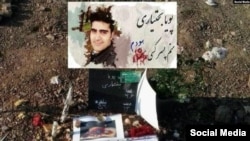Iran intensified its suppression of internal dissent Thursday, breaking up a memorial for a man killed in recent anti-government protests, flooding streets with security forces and slashing mobile internet access.
The repressive measures appeared aimed at dissuading Iranians from heeding activists’ calls for December 26 public gatherings to mark the end of a traditional 40-day mourning period for a prominent victim of last month’s protests, Pouya Bahktiari. The dayslong nationwide demonstrations, sparked by a November 15 government decision to sharply raise gasoline prices, marked Iran’s deadliest unrest in decades.
Iranian security forces make arrests at cemetery in Karaj, Iran, Dec. 26, 2019
A video received from Iran and verified by VOA Persian showed security personnel detaining several people at the Beheshe Sakineh Cemetery in the northern town of Karaj on Thursday.
Family members of Bakhtiari had appealed to the public and journalists to join them at his grave to mark 40 days since his killing and had used Instagram to spread the word. They had said he was shot in the head November 16, the second day of the protests.
The family’s social media campaign to raise awareness about Bakhtiari’s killing has made him one of the most high-profile fatalities of the demonstrations.
Social media users in Iran also had called for gatherings to be held nationwide to commemorate the hundreds of other people whom rights groups say were killed by security forces using live ammunition against the protesters.
Iranian officials have dismissed the reports of hundreds of fatalities as exaggerations without offering their own death toll.
The New York Times and Washington Post reported that some relatives of Bakhtiari made it to the cemetery for Thursday’s memorial, after others had been arrested earlier in the week, including his parents, for planning the public gathering.
But the video sent to VOA Persian showed security personnel leading several people away from the cemetery as bystanders screamed and shouted abuse at the officers.
Bystanders denounce security forces at Karaj cemetery, Dec. 26, 2019
In another clip filmed at the cemetery, a woman holding the camera said authorities were blocking access to Bakhtiari’s grave. A helicopter also flew overhead.
“The dictator is afraid even of a grave and has unleashed his hyenas,” the woman said, referring to Iranian Supreme Leader Ayatollah Ali Khamenei. Other bystanders could be heard shouting “let him go!” in apparent response to a person being detained.
VOA Persian could not independently confirm the number of those arrested at the cemetery.
Social media users also reported a heavy security presence on the streets of cities across Iran for a second day.
Basiji militiamen ride through a street in Fardis, Iran, Dec. 26, 2019
A clip from the town of Fardis in Tehran province showed government-backed Basiji militiamen riding through a street on motorbikes.
“They are trying to terrify people,” said a man filming the scene from the window of a building.
Iranian officers deploy in a Tehran square, Dec. 26, 2019
In a video from the Ariashahr district of the capital, Tehran, uniformed officers also could be seen crowding the edges of a traffic circle at Sadeghiyeh Square.
A report by state-approved news agency Tasnim quoted Tehran police chief Hossein Rahimi as saying there were no security incidents in the capital Thursday, thanks to the show of force by the security services.
In another move apparently designed to thwart the calls for anti-government gatherings, Iranian authorities further reduced mobile internet access to 5% of ordinary levels on several networks, according to London-based internet monitoring group NetBlocks.
A day earlier, semi-official news agency ILNA had reported that authorities began blocking mobile internet services in several provinces because of security concerns and would extend the outage as needed.
Iran imposed an almost complete nationwide internet shutdown on both fixed line and mobile networks for a week following the outbreak of the November protests. The move temporarily stopped Iranians from sending images and information about the protests to each other and the outside world, before the sharing of material resumed after internet access was restored.
This article originated in VOA’s Persian Service.








